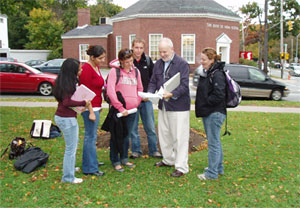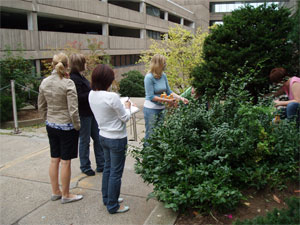 |
| Peter Mushkat and other Dal students discuss ideas for Balcom Square, the grassy bit on Coburg at Robie Streets. |
Halifax may be the “City of Trees,” but a few public spaces could use a facelift.
Take the crumbling concrete terrace off Market Street beside Scotia Square’s parkade, for example. Sze Ying Lui envisions radically redesigning it with more plants, water, quiet places to sit and a covered walkway.
“It would make it more enjoyable,” says the 21-year-old student from Hong Kong, in the final year of a double major in environmental science and community planning. “A place where people could chill and relax, have a break outside, and it gives a nicer view from all the offices above.”
Ms. Lui’s concept is one of many imaginative design solutions unveiled recently by the Plants in the Human Landscape class. Earlier this term, each student identified an urban site in need of a makeover. In an online vote, the class narrowed it down to seven sites.
The students – a diverse mix from Environmental Science, Planning, Biology, Philosophy and even Graduate Studies – collaborated in groups before working individually to draft 51 designs for their final class projects. Along the way, they got some input from Scotia Square officials and city planners, who will receive outlines of the students’ proposals. A competition is underway in the School of Planning to find the most interesting, attractive, cost-effective and practical design ideas for beautifying the city and to increase public awareness of urban beautification issues, The winning design may eventually become a reality.Â
Mike Leonard, 27, tackled the treacherous corner pathway across from CBC Radio, where Sackville Street meets Bell Road. Hundreds of pedestrians use it daily, but the path ends abruptly and forces them to walk along the busy road.
“That corner doesn’t function well,” says the Cole Harbour business grad, now majoring in Environmental Science. Realigning the path would enhance safety and accessibility, and Mr. Leonard would also add a resting place: steps and benches, and simple plantings of native species for minimal upkeep.Â
“People tend to care more about the natural environment if they can be exposed to it, and enjoy it regularly,” he says.
Balcom Square, the grassy triangle at the corner of Coburg Road and Robie Street, is an untapped oasis, says Peter Mushkat, an environmental law professor enrolled in the class. Surrounded by fast food eateries, the commemorative site could be a great spot for sunny lunch breaks. His project suggests some excavation and stonework, “for a sense of removal from the street,” with trees and shrubs and a water wall to muffle the traffic noise.
The class also proposes making two sites on campus more useful and welcoming: the boulevard between the SUB and FASS buildings, and the concrete terrace between the Killam Library and the chemistry building.
“With climate change becoming such a major concern, urban green space is a big thing right now,” says Anne Publicover, 21, of Moncton. Dal’s double major in community planning and environmental science is a “hot” combination with great career prospects, she adds.
“I felt I couldn’t really be a good urban planner in today’s world without an environmental background as well. The field is changing rapidly, and companies and municipalities are making real efforts to address these issues now,” she says.
Liu plans to take her green planning knowledge back home to Hong Kong, where a polluted river runs near her family’s home. “We are very much in need of this,” she says.

